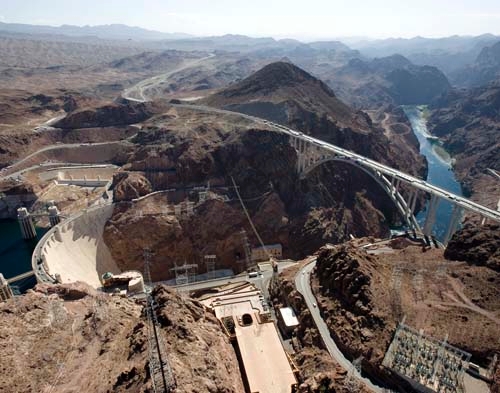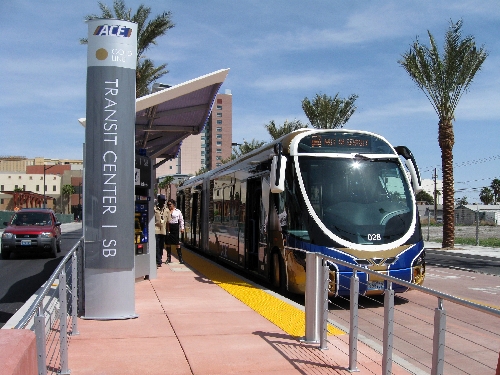Commuters got money’s worth with 10 projects



For a good chunk of the last decade, the state of Nevada and local cities had gobs of money to spend on major transportation projects.
The days of plump budgets are certainly in our rearview mirrors now, but it’s important to reflect on what was accomplished around the Las Vegas Valley to improve our commute.
The following is a list of 10 significant projects completed in the last 10 years, in no particular order of importance.
■ The Freeway and Arterial System of Transportation (FAST) building. The new Regional Transportation Commission facility boasts massive video screens lining the walls, which show engineers real-time footage of traffic along the Las Vegas Valley’s busiest freeways and arterials. Computers gauge the average rate of speed on the freeways, and estimated travel times to various exits are posted on digital message signs. Folks monitoring the screens can guide Nevada Highway Patrol troopers to accidents and enter messages alerting motorists of crashes that might cause delays. Cameras that feed the monitors can also be accessed by the public at home. Motorists can log onto their computers and click on cameras to plan their commute. FAST operates the ramp meters that began appearing in the valley in 2007. The agency’s engineers keep tabs on traffic signals throughout the valley and have the ability to tinker with lights that fall out of sync.
■ The Las Vegas Beltway (or whatever you choose to call it). Clark County broke ground on the 53-mile freeway-slash-expressway around the valley in the late 1990s, but the vital thoroughfare came to fruition during the 2000s. The Beltway is expected to become a full-fledged freeway by 2013, about a decade earlier than originally planned. Major progress during the last decade on the Beltway provided great relief to residents in Summerlin and Green Valley, who previously had to take surface streets or deal with the congestion on both Interstate 15 and U.S. Highway 95.
■ The Henderson interchange. As Green Valley and the eastern edge of the valley developed, traffic along the Beltway and U.S. Highway 95 intensified, causing major delays. This $240 million endeavor has been referred to as the Spaghetti Bowl of the South because of the flyovers that smoothly move traffic from one arterial to another. Also included in the bid was a much-needed interchange at the Beltway and Gibson Road.
■ Blue Diamond Road (State Route 160). This was one of the deadliest roads in Southern Nevada before the state’s transportation division made improvements from Interstate 15 to Rainbow Boulevard, primarily by widening the road from two lanes to eight. Traffic signals at major intersections were added along with turn pockets. Aside from making the route safer, the improvements also allowed Rainbow and Decatur Boulevard to become desperately needed north-south arterials.
■ Design-build north project. The widening of Interstate 15 between the Spaghetti Bowl and Craig Road was the first of its kind by the Nevada Department of Transportation. The project was finished early and within the $250 million budget. Officials credited that feat to cutting out the bidding process and having the design and construction teams work side-by-side.
Crews widened the aging freeway from six to 10 lanes from the Spaghetti Bowl to Lake Mead Boulevard, and from four lanes to eight lanes from Lake Mead Boulevard to Craig Road. The project included new bridges, lighting, landscaping and fiber optic cables to allow for the digital message sign system.
■ Widening of U.S. Highway 95 in the northwest. I know, I know, it’s ongoing and seemingly never-ending ever since the initial project was stalled in the late 1990s after the Sierra Club sued the state. But, still, plenty of progress was made during the past decade. Not only was the freeway widened and new lanes added to accommodate high-occupancy vehicles, but interchanges were built at Rancho Drive and at Jones, Decatur and Valley View boulevards.
■ Widening of U.S. Highway 95 to State Route 163. After the Sept. 11, 2001, terrorist attacks, tractor-trailers were prohibited from crossing Hoover Dam and instead were diverted to Laughlin. The situation was less than ideal because U.S. Highway 95 already was a dangerous two-lane highway with no median. The 60-mile route between Railroad Pass and Route 163, also known as Laughlin Highway, was widened to a four-lane divided highway. This was great news to truckers a few years ago, and it might be again because of the next project on the list.
■ The O’Callaghan-Tillman Memorial Bridge. The $240 million span truly is a spectacular sight, even though it might not work as well as expected. It is the largest single-span concrete bridge in the Western Hemisphere, and crews managed to build it in the treacherously narrow Black Canyon with only one tragic death. The divided four-lane bridge and new highway approaches keeps motorists from having to negotiate the sharp and painfully slow hairpin turns to Hoover Dam. Unfortunately, the bridge hasn’t made the trip between Arizona and Nevada as quick as anticipated because U.S. Highway 93 near the Hacienda hotel-casino narrows to two lanes, causing a severe bottleneck.
■ New transit system. The Regional Transportation Commission triggered some excitement about public transportation when it introduced its downtown express routes from Centennial Hills and the Summerlin area. The new Westcliff station at Westcliff and Durango drives seems to be most popular because it offers a quick and cheap trip to McCarran International Airport. The 140-space lot was full before Christmas, a clear indication that the commission’s goal of removing drivers from their personal vehicles and putting them in buses has been a success. New buses that resemble light-rail trains also intrigued residents who had not previously embraced public transportation. Commission leaders claim the buses are a fiscally more efficient mode of transportation than light-rail because, not only are they less expensive, but routes can be changed at no cost.
■ Interstate 15 to the California border. The stretch from Las Vegas to Primm once was a tangled traffic nightmare. Since I-15 was widened, the drive between Nevada and California has become much faster and smoother. Trucks have climbing lanes and travelers in faster vehicles no longer get stuck behind them for miles on end.
See? That is a pretty hefty list of accomplishments, and that is what happens when money is available. Undoubtedly, the next few years will continue to be difficult financially. Several other much-anticipated projects are on the horizon if the economy picks up and additional funding appears. Check in with me next week to find out what your transportation officials have in store.
If you have a question, tip or tirade, call Adrienne Packer at 702-387-2904, or send an e-mail to roadwarrior@reviewjournal
.com. Please include your phone number.
• Hinson Street between Charleston and Oakey boulevards will be closed to through traffic through Sunday for installation of storm drains.
• The intersection of Mountain View Boulevard and Hinson also will be closed.
LAS VEGAS REVIEW-JOURNAL












